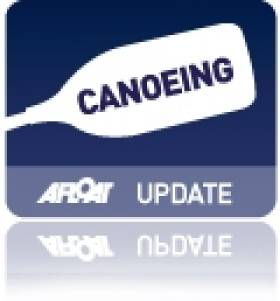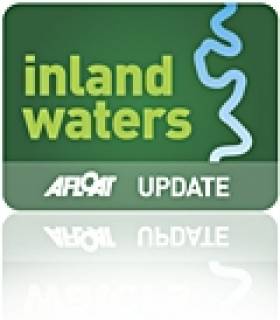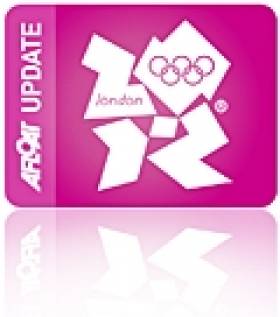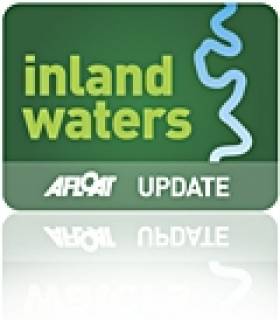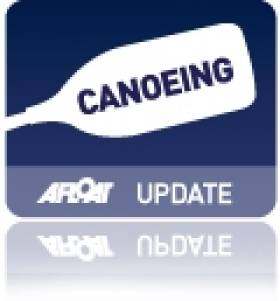Displaying items by tag: canoeing
Olympic Canoe Slalom Qualifying Spots Snapped Up in Lucan
#CANOEING - The Irish Times reports that Eoin Rheinisch and Ciarán Heurteau have secured their canoe slalom qualification spots for London 2012 after last weekend's selection races in Lucan.
Three places were up for grabs in the men's K1, with the third yet to be confirmed after fourth-placed Patrick Hynes contested a touch on a gate by third-place finisher Sam Curtis.
Canoeing Ireland's recently appointed general manager Karl Dunne said the objection is currently being considered.Meanwhile, in the women's K1, the qualifying spots went go Hannah Craig, Helen Barnes and Aisling Conlon.
The qualifiers will be part of the European Championships in Augusburg, Germany from 10-13 May, where Olympic spots are available for boats from two countries not already qualified.
NI Deaf Paddler To Carry Olympic Torch
#CANOEING - Irish canoe slalom paddler Matthew Sykes has secured a place on the Olympic torch relay this summer.
“I am only one of only 8,000 people selected to carry the London 2012 Olympic torch relay," the Northern Irishman told IrishCanoeSlalom.com. "It was a lovely surprise to find out that I was going to carry the Olympic torch.
"To be the first deaf person in Northern Ireland to be chosen is a real privilege and I think it will be a great experience.
"I think it will be a great day when the torch comes to this country and I am sure everyone will be down there to watch so it will be a good experience.”
Sykes will carry torch in Dundonald on 3 June. More details will be available soon on Sykes' website at www.matthewsykes.co.uk/news
As previously reported on Afloat.ie, the Olympic torch relay begins in Plymouth on 19 May and finishes at the Olympic Stadium on 27 July, and includes a visit to Dublin on Wednesday 6 June.
Derelict Island Cottage Becomes Canoeing Sanctuary
#CANOE – An old derelict cottage on Trannish Island has been given a new lease of life, recently refurbished and launched as bothy accommodation for canoeists on the popular Lough Erne Canoe Trail in County Fermanagh.
Managed by the Share Discovery Village in Lisnaskea, this new bothy has been made possible with investment from the South West Action for Rural Development under the Rural Development Programme, Share Discovery Village and Fermanagh District Council and will cater for up to twelve canoeists with bunkhouse style sleeping space, a large living area and wood burning stove. A solar powered shower block and self composting toilet block has also been built adjacent to the refurbished cottage, providing a fantastic resource for canoeists and a wonderful addition to Fermanagh's tourism draw.
Rory Martin, Marketing Officer at Share Discovery Village, explains, "It is fantastic to see such a great facility specifically catering for canoeists here in Fermanagh. Our waterways are ideal for visiting paddlers and we are delighted to now be able to offer unique bothy accommodation that successfully compliments our natural environment."
Rory continued, "The bothy will be perfect for a wide range of canoeists both experienced and those heading out on their first paddle with a short introductory session from our instructors here at Share. Families and groups of friends will be able to get back to nature with canoe clubs and youth groups able to book exclusive use of the bothy and neighbouring campsite for larger group trips."
Developed by the Countryside Access and Activities Network (CAAN), the Lough Erne Canoe Trail is no stranger to winning innovation accolades and indeed was the first Northern Irish project to be recognised by the British Urban Regeneration Waterways Renaissance Awards in 2008.
Chris Scott, CAAN's Activity Tourism Manager explains, "Of the five official inland canoe trails in Northern Ireland, Lough Erne would be the most popular by quite some distance. With sheltered bays, narrow channels and an abundance of islands, this 50 km trail is perfect for all levels of canoeists visiting the Fermanagh Lakelands."
Chris Scott continued, "Now with comfortable accommodation and living space on a deserted island, this bothy project is set to become the feather in Lough Erne's cap and exactly what canoeists visiting this quiet corner of Northern Ireland are looking for."
With bothy accommodation on Salt Island remaining popular amongst canoeists on Strangford Lough and an old fisheries cottage currently being converted in Port Moon Bay on the Causeway Coast in County Antrim, Northern Ireland is continuing to set the standard for high quality canoeing facilities throughout Europe.
New Mobile Guide to Lough Derg Trails
#INLAND WATERWAYS - A new mobile app that guides visitors around the trails of Lough Derg has gone live, the Clare Champion reports.
More than 20 trails are included in the app, from walking to cycling, driving, cruising and canoeing.
The app - developed in partnership between Shannon Development and US firm EveryTrail - uses Google Maps and the GPS system in smartphones to pinpoint trails near the user's location.
Users can download route descriptions, images and notes, get directions to the starting point and follow the the pre-plotted course.
The Lough Derg Trails app is available for iPhone and Android devices.
The Clare Champion has more on the story HERE.
'Podium Athletes' Face Funding Cuts in 2013
#OLYMPICS - Yesterday Ireland's Olympic hopefuls celebrated recognition of their success in the 2012 round of funding.
But cuts to the budget of the Irish Sports Council (ISC) have prompted a "major" review of high performance programmes from 2013 onwards, the Irish Independent reports.
Finbarr Kirwan, director of high performance at the ISC, said: "Changes are coming, things are tight and we will have to make strategic cuts in the next two years."
The result could be fewer grant awards of lesser value for athletes, as Olympic qualification standards are set to get tougher from here on out.
The two tiers below 'podium class' - in which individuals receive awards of €20,000 and €12,000 respectively - are expected to be hardest hit in the review.
As previously reported on Afloat.ie, canoeing's Eoin Rheinisch, swimmer Grainne Murphy and sailors Annalise Murphy, Peter O'Leary and David Burrows each received the top level of funding of €40,000 each, which is on a par with last year's support.
The Irish Independent has more on the story HERE.
Waterways Ireland Issues a 'Special Notice' to Mariners for 2012
#WATERWAYSIRELAND – In its first notice to mariners of 2012 Waterways Ireland has published a list of the most important aspects of waterways regulations for boat owners. It includes the Registration of Vessels, Canal Permits, Events Held on the Waterways, Berthing in Public Harbours and many more useful reminders for the use of the waterways this coming season. Full details of the 'special notice' from the Inspector of Navigation Charles J Lawn Lt Cdr (rtd) is below:
Registration of Vessels
All vessels using the Shannon Navigation and the Erne System must be registered. Only open undecked boats with an engine of 15 horsepower or less, on the Shannon Navigation, and vessels of 10 horsepower or less, on the Erne System, are exempt.
Canal Permits
All vessels using the Grand and Royal Canals and the Barrow Navigation must have a current valid Permit displayed before being navigated or moored.
Events Held on the Waterways
All organised events taking place on the waterways must have the prior approval of Waterways Ireland. Application forms for this approval and the associated indemnity form may be had from the Inspectorate offices.
Berthing in Public Harbours
On the Shannon Navigation and the Shannon-Erne Waterway craft may berth in public harbours for five consecutive days or a total of seven days in any one month during the period 1 April to 31 October. This also applies in Clondara / Richmond Harbour on the Royal Canal and in Shannon Harbour and the Tullamore Spur Line on the Grand Canal.
On the Erne System no vessel may berth at a public mooring for more than 48 hours without a four hour intermission.
Pump Out Berths
Masters of vessels should note that it is not permitted to berth at pump out stations.
Smart Cards
Waterways Ireland smart cards are used to operate certain locks, to access the service blocks and to use the pump-outs along the navigations. Electrical Power is also available using smart cards at a limited number of public mooring locations, including Scarriff, Shannonbridge, Garrykennedy, Carrick and Ballina (Tipperary). Operating instructions are displayed in English, French and German.
Passenger Vessel Berths
Masters of vessels should not berth on passenger vessel berths where it is indicted that an arrival is imminent. Passenger vessels plying the navigations generally only occupy the berths to embark and disembark passengers and rarely remain on the berths for extended periods or overnight.
Lock Lead-in Jetties
Lead-in jetties adjacent to the upstream and downstream gates at lock chambers are solely for the purpose of craft waiting to use the lock and should not be used for long term berthing.
Vessel Wash
Vessel wash, that is, the wave generated by the passage of the boat through the water, can sometimes be large, powerful and destructive depending on the hull shape and engine power of the vessel. This wash can be detrimental to other users of the navigation when it strikes their craft or inundates the shoreline or riverbank. Masters are requested to frequently look behind and check the effect of their wash particularly when passing moored vessels, on entering harbours and approaching jetties and to be aware of people fishing or recreating on the riverbank.
Speed Restriction
A vessel or boat shall not be navigated on the Shannon Navigation at a speed in excess of 5 kph when within 200 metres of a bridge, quay, jetty or wharf, when in a harbour or canal or when passing within 100 metres of a moored vessel or boat.
Vessels navigating the Shannon-Erne Waterway should observe the general 5 kph speed limit which applies along the waterway. This is necessary in order to prevent damage to the banks caused by excessive wash from vessels.
Vessels navigating the Erne System should observe the statutory 5 kt / 6mph/10kph speed limit areas.
Bank Erosion
Narrow sections of all the navigations are particularly prone to bank erosion due to the large wash generated by some craft. Masters are requested to be vigilant and to slow down to a speed sufficient to maintain steerage when they observe the wash of their craft inundating the river banks.
Unusual Waterborne Activity
Unusual waterborne vessels may be encountered from time to time, such as, hovercraft or amphibious aircraft / seaplanes. Masters of such craft are reminded to apply the normal "Rule of the Road" when they meet conventional craft on the water and to allow extra room to manoeuvre in the interest of safety.
Sailing Activity
Mariners will encounter large numbers of sailing dinghies from late June to August in the vicinity of Lough Derg, Lough Ree and Lower Lough Erne. Vessels should proceed at slow speed and with due caution and observe the rules of navigation when passing these fleets, as many of the participants are junior sailors under training.
Rowing
Mariners should expect to meet canoes and vessels under oars on any part of the navigations, either recreating, in training or in competition but more so in the vicinity of Athlone, Carrick-on-Shannon, Coleraine, Enniskillen and Limerick. Masters are reminded to proceed at slow speed and especially to reduce their wash to a minimum when passing these craft as they can be easily upset and swamped due to their very low freeboard and always be prepared to give way in any given traffic situation.
Canoeing
Canoeing is an adventure sport and participants are strongly recommended to seek the advice of the sport's governing bodies i.e The Irish Canoe Union and the Canoe Association of Northern Ireland, before venturing onto the navigations.
Persons in charge of canoes are reminded of the inherent danger to these craft associated with operating close to weirs, sluice gates, locks and other infrastructure particularly when rivers are in flood and large volumes of water are moving through the navigations due to general flood conditions or very heavy localised precipitation e.g. turbulent and broken water, stopper waves. Shooting weirs is prohibited without prior permission of Waterways Ireland.
Portage is required at all locks, however, a heavily laden canoe may be put through a lock unmanned provided it is attended with a head and stern line.
Fast Powerboats and Personal Watercraft (Jet Skis)
Masters of Fast Powerboats (speed greater than 17kts) and Personal Watercraft (e.g.Jet Skis) are reminded of the inherent dangers associated with high speed on the water and especially in the confines of small bays and narrow sections of the navigations. Keeping a proper look-out, making early alterations to course and /or reducing speed will avoid conflict with slower vessels using the navigation.
Age Restrictions
In the Republic of Ireland you have to be at least 16 years of age to operate a PWC e.g Jetski and 12 years of age or over to operate a vessel with more than a 5 hp engine.
Prohibition on Swimming
Swimming in the navigable channel, particularly at bridges, is dangerous and is prohibited due to the risk of being run over by a vessel underway in the navigation.
Towing Waterskiers, Wakeboarders, Doughnuts etc
Masters of vessels engaged in any of these activities are reminded of the manoeuvring constraints imposed upon their vessel by the tow and of the added responsibilities that they have to the person(s) being towed. These activities should be conducted in areas which are clear of conflicting traffic. It is highly recommended that an person additional to the master be carried to act as a "look-out" to keep the tow under observation at all times.
Lifejackets and Personal Flotation Devices (PFD's)
Lifejackets and PFD's are the single most important items of personal protective equipment to be used on a vessel and should be worn especially when the vessel is being manoeuvred such as entering / departing a lock, anchoring, coming alongside or departing a jetty or quayside.
In the Republic of Ireland all persons on board any craft of less than 7m (23 ft) must wear a lifejacket or PFD while on board an open craft or on the deck of a decked craft that is not made fast to the shore. This requirement also applies to Personal Watercraft Craft and any vessel or object being towed e.g. waterskier, wakeboarder, doughnut, banana etc.
Danger Area
The attention of mariners is drawn to the Army Firing Range situated in the vicinity of buoys No's 2 and 3, on Lough Ree in the Shannon Navigation.
Shannon Navigation, Portumna Swing Bridge Tolls
No attempt should be made by Masters' of vessels to pay the bridge toll while making way through the bridge opening. Payment will only be taken by the Collector from Masters when they are secured alongside the jetties north and south of the bridge.
Shannon Navigation, Abbey River and Sarsfield Lock, Limerick
The attention of all users of this stretch of the Shannon Navigation is drawn to the published notices regarding navigation. Users are advised to contact the ESB Ardnacrusha Hydroelectric Power station before commencing their passage to ascertain how many turbines are currently running. It is advised NOT to undertake a voyage if more than one turbine is operating, due to the increased velocity of flow in the navigation, which can be dangerous. This situation may also arise when flood conditions prevail. Further, passage of Sarsfield Lock should be booked on 353-87-7972998, on the day prior to travel and it should be noted also that transit is not possible two hours either side of low water.
Lower Bann Navigation
The attention of all users is drawn to the "Users Code for the Lower Bann", in particular to that section covering "Flow in the River" outlining the dangers for users both on the banks and in the navigation associated with high flow rates when the river is in spate. Canoeists should consult and carry a copy of the "Lower Bann Canoe Trail" guide issued by the Canoe Association of Northern Ireland.
Overhead Power Lines (OHLP)
The attention of all is drawn to the dangers associated with overhead power lines in particular sailing vessels, sailing dinghys and workboats with cranes. Vigilance is required especially in the vicinity of slipways and dinghy parks, while voyage planning is a necessity in order to identify the location of overhead lines crossing the navigations. If the vessel or its equipment comes in contact with an OHLP, do NOT attempt to move the equipment or a person if either is still in contact with, or close to, the OHLP. The conductor may still be alive or re-energise automatically. Maintain a 5 m clearance, if possible, and prevent third parties from approaching you or your vessel because of the risk of arcing. Contact the Coast Guard for assistance. Fishermen are also reminded that a minimum ground distance of 30 metres should be maintained from overhead power lines when using rod and line.
Submarine Cables and Pipes
Masters of vessels are reminded not to anchor their vessels in the vicinity of submarine cables or pipes in case they foul their anchor or damage the cables or pipes
Aids to Navigation – Shannon Navigation - Recognition
Masters should consult Waterways Ireland Marine Notices to inform themselves of the roll-out of the change over from the colour black to green for starboard hand marks. Topmarks remain the same i.e square on starboard and circular on port marks. White arrows on markers indicate the safe water side of the mark.
Caution to be Used in Reliance upon Aids to Navigation
The aids to navigation depicted on the navigation guides comprise a system of fixed and floating aids to navigation with varying degrees of reliability. Therefore, prudent mariners will not rely solely on any single aid to navigation, particularly a floating aid to navigation. With respect to buoys, the buoy symbol is used to indicate the approximate position of the buoy body and the ground tackle which secures it to the lake or river bed. The approximate position is used because of the practical limitations in positioning and maintaining buoys in precise geographical locations. These limitations include, but are not limited to, prevailing atmospheric and lake/river conditions, the slope of and the material making up the lake/river bed, the fact that the buoys are moored to varying lengths of chain, and the fact that the buoy body and/or ground tackle positions are not under continuous surveillance. Due to the forces of nature, the position of the buoy body can be expected to shift inside and outside the charted symbol. Buoys and perches are also moved out of position by those mariners who use them to moor up to instead of anchoring. Further, a vessel attempting to pass close by always risks collision with a yawing buoy or with the obstruction that the buoy or beacon / perch marks.
- rowing
- canoeing
- Registration of Vessels
- Canal Permits
- Events Held on the Waterways
- Berthing in Public Harbours
- Pump Out Berths
- Smart Cards
- Passenger Vessel Berths
- Lock Leadin Jetties
- Vessel Wash
- Speed Restriction
- Bank Erosion
- Unusual Waterborne Activity
- Sailing Activity
- Fast Powerboats and Personal Watercraft (Jet Skis)
- Age Restrictions
- Towing Waterskiers, Wakeboarders, Doughnuts
Egan Sets Sights on Olympic Canoeing Spot
#CANOEING - The Evening Herald reports that top Irish canoeist Jenny Egan is headed to Florida for a few months of training towards a spot at the 2012 Olympics.
A sprint and marathon racer, Egan was named as The Irish Times/Irish Sport Council's Sportswoman of the Month for May 2010 in recognition of some very impressive performances.
Indeed, the Kildare native enjoyed much success in 2012, with second place in the 5000m at the World Sprint Cup in the Czech Republic and a new Irish record in the 500m at the Canoe Slalom Worlds in Hungary among her achievements.
Heading into 2012, the Salmon Leap club member will surely be shrugging off setbacks like her crash in the heat and humidity of Singapore at the Canoe Marathon Worlds last October.
The new year brings a new focus, as Egan will concentrate on the 500m and 200m K1 sprint distances for the London games, with the final qualifiers - for just 15 spots - taking place in Poland in April.
The Evening Herald has more on the story HERE.
Canoeing Ireland Looking for New General Manager
#JOBS & CAREERS - Canoeing Ireland, the national governing body for canoe sports in Ireland, has a vacancy for a general manager based at its headquarters in Dublin.
The successful candidate will "lead the organisation, its members and volunteers as it continues to support and advance canoeing in Ireland over the coming years".
Aside from providing leadership to the organisation in its activities, the role involves providing support to the executive and board in developing and implementing a new strategy for Canoeing Ireland, formerly the Irish Canoe Union.
The job will also involve the provision of support to both recreational canoeists and high performance athletes, and ensuring that the body is managed and administered effectively for the benefit of all members.
The ideal candidate will hold a relevant third level qualification; have a proven track record with at least five years' work experience in a senior management position; can demonstrate experience of financial management, reporting, and budgetary control procedures; have experience in working with high performance athletes aservices providers.
Knowledge of change management and experience of co-ordinating and working with professional service providers would be an advantage.
The closing date for applications is tomorrow, Friday 11 November 2011. Interested parties can apply online HERE.
Irish Paddlers Place Well in Singapore
Ireland's canoeists distinguished themselves at the ICF Canoe Marathon World Championships in Singapore last weekend, as The Irish Times reports.
In the women's K1 event, Jenny Egan placed an impressive eighth out of 25 entrants.
Egan kept pace with eventual winner Renata Csay of Hungary until one-third of the way into the 28.5km race.
But temperatures in the 30s and 80% humidity took their toll on the Salmon Leap paddler and her challenged faded instantly.
Meanwhile, her brother Peter Egan placed 11th in the men's K2 with partner Neil Fleming, missing out on a better place due to Egan's cramping before the end.
Irish Contingent in Singapore for Canoe Marathon Worlds
An Irish contingent is in Singapore this weekend to compete at the 19th ICF Canoe Marathon World Championships.
In the women's K1, Jenny Egan - the Irish Times/Irish Sports Council Sportswoman of the Month in June this year - was set to face six laps of the 4.2km course with six portages in the women's K1.
Meanwhile, her brother Peter Egan - teaming today with Neil Fleming in men's K2 - is scheduled to face seven laps with seven portages.
Fleming and Richard Hendron were also set to take on the same course in the men's K1.
Live streaming of the weekend's competition, which concludes this evening, is available HERE.






























